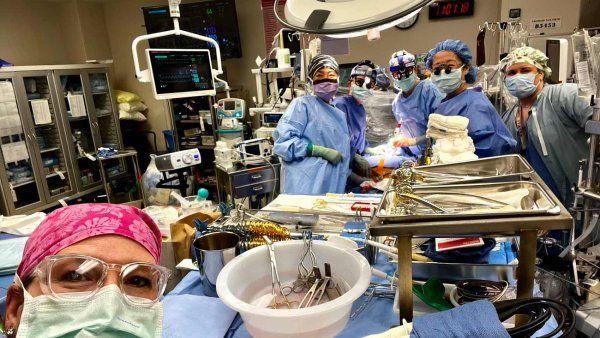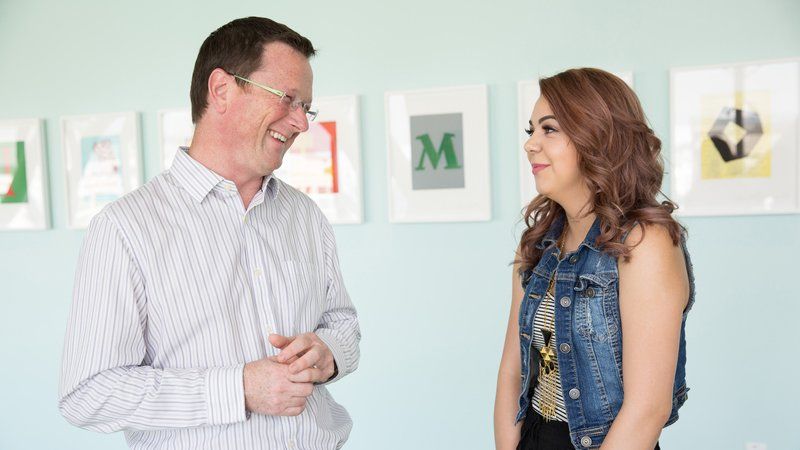
Piper Wood had her first seizure in a setting meant for sunscreen, snorkels, shovels, and pails. The island was remote – that was the point of this family vacation. Six months old and turning blue, Piper finally calmed down and drew breath again after the island’s well-trained doctor brought her hour-long seizure to a halt by administering a mix of morphine and water into one of her tiny veins. Tim and Ashley Wood needed to get their daughter to a better-equipped hospital immediately, but night had fallen and no medevac could land in the dark. Word spread quickly, and, one by one, villagers arrived in their cars and parked side by side with their headlights shining on the runway.
Eight years later, Piper’s path is still illuminated by the bold and remarkable acts of people surrounding her. Piper was diagnosed with Dravet syndrome, a catastrophic form of epilepsy that presents in the first year of life and is marked by fierce seizures, sometimes hundreds in the course of a day, that eventually lead to cognitive and social impairment. Dravet is epilepsy at its most extreme; some seizures can be lethal or so intractable that children end up being intubated to resume the flow of oxygen. Yet even milder forms of epilepsy – with less frequent or different types of seizures – can upend families.
“An epilepsy diagnosis is very difficult to deliver to a family because the sheer nature of seizures is just so unpredictable,” says Joseph Sullivan, MD, director of UC San Francisco’s Pediatric Epilepsy Center and Piper’s neurologist. “In our pediatric patients with epilepsy, about a third continue to have seizures, even with optimal treatment.”
Piper is among them. So are Lew Parker and Sam Vogelstein. At times, during the course of their treatment, all three could be doing just fine at school or on a lazy Sunday and then, suddenly, time stops and a seizure hits.
In families that know to expect one or two seizures a week, if their child has had only one by Thursday, for example, do they make that trip to the grocery store?
“It’s a chronic illness that rocks your very core stability,” says Jen Parker, Lew’s mother. “To me, the biggest difference from so many terrible medical diagnoses that can befall people is that you never rest again. It’s not like with other illnesses where finally at night you get a child to bed and you can recover. Nighttime is Lew’s most dangerous time.”
There are several types of seizures, and most are not as dramatic as the stiffening and jerking of grand mal seizures – or tonic-clonic, as they are more commonly called – yet they are just as intrusive. Sam has had as many as 100 seizures a day, between 10 and 20 episodes an hour, during which his eyes glaze over, his head bobs, and his jaw slackens. After 15 seconds or so, he would regain consciousness and resume his sentence, pack his lunch, or block a joust in a fencing match. As he drifted in and out during the course of the day, Sam’s literal absence of mind made it difficult for him to be fully present for lessons at school and lessons in life.
These children have more than epilepsy in common. Their parents have partnered with physicians and scientists to relentlessly test and defy conventional medical wisdom, tear through red tape, and reimagine a whole new care delivery model. They’ve done it for love, fear, and change – not just for their kids, but for those in the waiting room next to them. And their physicians and scientists have jumped fences into territories foreign to them. The partnerships they’ve forged and the ground they’ve covered are an audacious tale of 21st-century medicine in a university medical center.
A Maelstrom of the Mind
Epilepsy is as common as breast cancer and more common than multiple sclerosis, cerebral palsy, and Parkinson’s disease combined. It affects 1 in 26 people in the U.S. – including more than 300,000 children under the age of 14 – with a wide spectrum of biological, cognitive, and psychological consequences. Yet some 70 percent of time, doctors can’t identify the cause of a child’s epilepsy.
Seizures happen when the electrical currents that regulate interactions among neurons surge and create a firestorm of activity. “Our brains are governed by a balance between excitation and inhibition,” explains Maria Roberta Cilio, MD, PhD, director of research at UCSF’s Pediatric Epilepsy Center. “When that balance is right, our thoughts and movements flow nicely. If a group of neurons is not working properly – they might start firing all together – our bodies move against our will and produce a seizure.”
To me, the biggest difference from so many terrible medical diagnoses that can befall people is that you never rest again.
Nearly 80 percent of the human brain is developed by age three, and intractable seizures can wreak havoc with that critical process. When they’re less than two minutes long, seizures themselves don’t induce brain injury. However, if they are frequent, they can impact cognition. And when seizures last longer than 15 minutes, studies have shown that they can potentially induce brain damage. “The big question is whether the seizures are doing damage,” says Cilio. “It is very likely that in children with genetic diseases, it’s the underlying genetic defect that may cause cognitive impairment, more than the seizure itself.”
For instance, the gene defect that causes Dravet syndrome, an SCN1A mutation, interferes with the brain’s sodium channels, which regulate the firing of neurons. All told, there are more than 70 such genetically caused epilepsies that involve similar problems in potassium and calcium channels essential to brain function. Physicians try to bring seizures under control, while they search for therapies targeting these underlying causes.
Born in Italy, Cilio left Europe to direct the Neonatal Epilepsy Program in UCSF’s Neuro-Intensive Care Nursery (NICN). The first of its kind in the world, the NICN is exactly where she needed to be to save kids and move the field forward. “The NICN is a place where babies are diagnosed as early as possible so you can try treatments that address the cause,” says Cilio. “If you diagnose later, you are only addressing the symptoms,” she adds. Her recent studies have shown that a drug called carbamazepine – an older antiepileptic used very rarely, if at all, in the NICU – promptly and safely controls seizures in neonates with benign and severe forms of neonatal epilepsy. Spared millions of seizures over the course of a lifetime that would likely have been cut short, these children and their brains are thriving.
Just How Many Is Too Many?
The idea came to them on the John Muir Trail. Piper’s doctor, Joseph Sullivan, and dad, Tim Wood, were on an annual backpacking trip organized by friends they had in common. Conversation that foggy morning inevitably turned to Piper, who was struggling. The only treatment that had shown any efficacy – a high-fat, low-carb, low-protein ketogenic diet – was faltering, and she was having two- to three-day cycles of 20 to 30 seizures a day.
Wood had a gut instinct that Dravet was far more prevalent than 1 in 30,000 – an estimate derived a half-century ago, well before the gene for Dravet, SCN1A, was discovered in 2001. There’s much at stake in getting the diagnosis and prevalence of Dravet right. Early on, the disorder can look like benign febrile seizures, a much milder form of epilepsy that may be treated with drugs that can exacerbate Dravet. And with an assumed small universe of patients, the pharmaceutical industry had little incentive to invest in finding new, more effective therapies.

Parents like Tim Wood (shown with two of his kids, Owen and Piper) work tirelessly to loosen epilepsy’s grip on their children by questioning the boundaries of science and care. Photo: Gabriela Hasbun
“This is me shouting, a dad with a daughter who’s got Dravet,” exclaims Tim. “I had to do something. I am a salesperson with a certain skill set. I wanted to brand Dravet, make it a household name.”
Against the backdrop of the High Sierra, Sullivan had an idea. He would approach a colleague at UCSF – Yvonne Wu, MD, MPH, who is both a pediatric neurologist and an epidemiologist – and ask her to use electronic health records from Kaiser to see if they could prove that Dravet was more prevalent. Two years and over 125,000 electronic health records later, Wu found that the incidence of Dravet is actually double the old estimate. “We were able to show that Dravet is not so rare,” says Wu. “It is something all pediatricians need to consider when they see kids who are presenting with febrile seizures.”
Wu is confident that the study will have an impact and save lives. She credits Sullivan and Wood for the impetus. “It is very grounding to partner with patients and families,” she says. “Sometimes, as researchers and physicians, we get caught up in trying to understand the answers to questions that are burning in our minds but may not be the most important questions to families who are actually affected by the disorder.”
Patient families bring about change and, just as important, community. “People out there with a voice, like Tim [Wood], get momentum going, and it hits a tipping point,” says Sullivan. “In the course of my five years of child neurology and epilepsy training, we identified only one or two children with Dravet. Now I have 40 kids with Dravet in my practice. And I can direct them to a foundation and a Facebook page. This gives families identity and support. It really impacts their kids’ treatments.”
When Risks Match Rewards
Evelyn Nussenbaum, Sam’s mom, was sitting in a room with the CEO of a company that manufactures a purified strain of cannabinoid that has been stripped of tetrahydrocannabinol (THC), the psychotropic component of marijuana that gets people high. The CEO had flown in from London to UCSF to talk to Nussenbaum and her son’s doctor, Cilio, about administering their drug, Epidiolex, to Sam. The drug had never before been tried in a person with epilepsy, nor in a child, and Sam would be taking it at a dose that was double, by percentage of body weight, what anyone else had ever taken.
The two were hashing out the rules of what would be Sam’s own clinical trial – which would be conducted in London, given the complexities of laws in the U.S. governing cannabinoids. Sam had 68 seizures on Thursday, his first day in London. At the end of that day, they picked up the Epidiolex at the hospital pharmacy and started the medication that night. Sam had 10 seizures on Friday, five on Saturday, 10 on Sunday, and six on Monday. A vast improvement.

UCSF Benioff Children’s Hospital San Francisco in Mission Bay. Photo: Susan Merrell
“In three days, Sam was taking a zip line above Hyde Park, with a helmet and harness,” says Nussenbaum. But they couldn’t bring Epidiolex home – it would literally have been a criminal act.
Cilio spent countless hours defining a treatment protocol – including establishing rules for dosing, laboratory testing, and clinical and EEG evaluations before and during treatment. She filled out reams of paperwork, talked to government officials, won approval from UCSF’s Institutional Review Board, and lobbied the U.S. Food and Drug Administration (FDA) to allow a compassionate-use trial of Epidiolex, which the FDA classifies as a drug at high risk for abuse. Three months later, she got the permit and a visit from a Drug Enforcement Administration agent, who insisted she store the drug in a half-ton steel safe in her office. UCSF Benioff Children’s Hospital San Francisco would become the first U.S. facility ever to administer Epidiolex to children with epilepsy. Along with Sam, Piper and Lew were among the very first patients to receive the drug.
Now, three years later, Sam has been seizure-free for 10 months on a drug cocktail that includes Epidiolex. He is thinking about getting his driver’s license. Piper’s initial response was encouraging, but she is still struggling with weekly seizures. Lew had a negative response to the drug. Cilio has wrapped up a trial of Epidiolex in 162 patients, with results showing a 36-percent reduction on average in monthly motor seizures. Cilio believes that, though it’s not a magic bullet, the cannabinoid in Epidiolex can be a useful tool, in either plant-derived or synthetic form and especially in combination with other antiepileptic drugs.
Though the process was arduous, Cilio believes Epidiolex was a goal well worth seeking for her patients. “A long chain of people were brave in this story,” says Cilio. “When I present on this topic, I am clear that this study was possible because I was at this institution.”
From Fish Tank to Bedside
Sullivan met Scott Baraban, PhD, in a hallway soon after starting at UCSF, years ago. They both were working on Dravet, though Sullivan’s focus was on patients and Baraban’s on research. As director of the Epilepsy Research Laboratory in the Department of Neurological Surgery, Baraban was busy honing a zebrafish-based approach to Dravet – one he has since perfected. Dravet may be the first of many forms of epilepsy aided by the humble zebrafish. There are more than 70 known types of epilepsy of genetic origin, and the Baraban lab is creating a zebrafish model for every one of them. He uses a new technology called CRISPR to impose the exact genetic glitch in the fish that children like Piper have. Then, following discussions with Sullivan, he models the clinical symptoms in zebrafish.

Scott Baraban and Joseph Sullivan in the UCSF Epilepsy Research Laboratory, where Baraban is using zebrafish to aid drug discovery. Photo: Steve Babuljak
“Joe tells me exactly what symptoms patients have and the specifics of what medications he uses and in what sequence,” says Baraban, who now holds the William K. Bowes, Jr., Endowed Chair in Neuroscience Research. “These conversations directly contributed to how we decided we would validate our models. Do our Dravet fish have seizures? Do our Dravet fish react the same way to the same treatments? The answer to both questions is yes.”
Zebrafish offer many advantages in finding new cures rapidly. Unlike mice, which may produce only one or two pups per litter with the mutation, adult zebrafish can give birth within a week to over 100 larvae with the same mutation. The larvae have no scales, so they absorb drugs from the water surrounding them, enabling the researchers to test multiple drugs on up to 100 larvae at a time. Baraban and his colleagues recently developed a microfluidic chip that records the EEG activity of the fish to measure a given drug’s effectiveness against electrical seizures. And, because the fish are translucent, scientists can also use sophisticated neuroimaging to watch the activity of their entire brains while they are having seizures. All of these approaches were pioneered in the Baraban laboratory.
“In less than three years, we have tested more than 2,000 FDA-approved drugs using this Dravet fish. We have found five promising drugs,” says Baraban, “and they are going straight from zebrafish to patients, in some cases.” That’s a process that typically takes 15 years and costs $800 million. Baraban and his team went from concept to patient in less than five years and for less than $5 million.
Sullivan is testing one of those promising drugs, fenfluramine, right now. Another, lorcaserin, is being tested in Colorado, and Baraban just published his latest results in the journal Brain. All five children being treated with lorcaserin are having fewer seizures, and one child has experienced an extraordinary 90-percent reduction. The primary side effect is relatively harmless – appetite reduction.

Zebrafish offer many advantages in finding new cures rapidly. Photo: Steve Babuljak
As promising as lorcaserin or fenfluramine may be as treatments for epilepsy, they never would have surfaced if Baraban hadn’t used a study design that eliminates investigator bias. He and his colleagues buy libraries of drugs and do the testing blind. Then, once they identify drugs that show signs of efficacy, they work backward to figure out the common mechanism. Their first unexpected discovery of an effective drug was clemizole – an antihistamine, a class of drugs known to worsen seizures. That discovery was published in the journal Nature Communications in 2013. They have since determined that clemizole, as well as three subsequently identified drugs (lorcaserin, fenfluramine, and trazodone), act on serotonin receptors to create an inhibitory response that counteracts the abnormal excitatory impulses that characterize seizures.
To greatly expand this zebrafish-based precision medicine approach, Baraban has created fish for 20 of the genetically based forms of human epilepsy. He has about 50 more to go. “Once we have all these fish in-house, we plan to put them in an open resource center that maintains zebrafish colonies,” says Baraban. “Then any lab can just order a fish and start their research.”
That way, scientists anywhere can search for treatments for Piper and Lew and Sam all at once and as fast as they can.
Care Built on Community
“A lot of what we do in clinic is listen,” says Joseph Sullivan, MD, director of the UCSF Pediatric Epilepsy Center. “We give families that sense that they are not alone. I tell them, ‘I have many other patients who are in your same scenario.’”
Sullivan has acted on all that listening to create a new model of care delivery that addresses the whole child and the whole family. Called the Pediatric Epilepsy Center of Excellence (PECE), the center will provide new services to surround families with a compassionate, facilitative care community. With input from parents like Jen Parker, he is working hard to build out the program – which he says is near and dear to his heart – one specialist at a time.
Parker, whose six-year-old son, Lew, has a drug-resistant form of epilepsy, has spent more than her fair share of time in doctors’ offices and actively participates in focus groups of families with kids who need constant care. Parker not only identifies with the stories of other families, she logs those anecdotes into the fount of knowledge she shares with Sullivan.
“The marital and employment issues are quite real. Some parents divorce or have to stop working,” says Parker. “PECE exists to show that you can change outcomes if you provide better support for the whole family. It’s where fear and hope exist together.”

Joseph Sullivan talks with his patient Monica Martinez, 17, in the waiting area of the UCSF Benioff Children’s Hospital Pediatric Brain Center. Photo: Susan Merrell
In its nascent stages, Sullivan’s program is being built out to include the following experts:
- Educational liaison to assist families searching for appropriate educational placements, given the high incidence of learning differences associated with epilepsy.
- Clinical trial coordinator to provide patients with improved access to new therapies and trials.
- Pediatric psychiatrist to monitor and follow families’ personal journeys, while providing individualized treatment and support.
- Marriage and family therapist to help families deal with the impact of epilepsy.
- Family wellness specialist to offer a range of complementary therapies, including yoga, mindfulness, mediation, and stress management.





